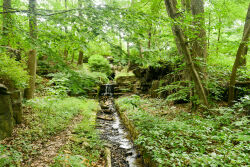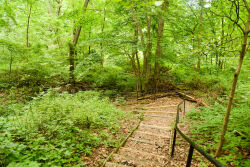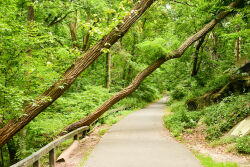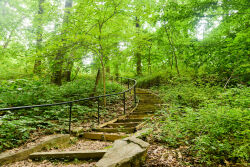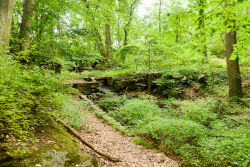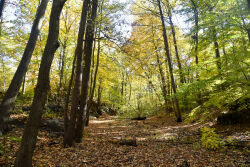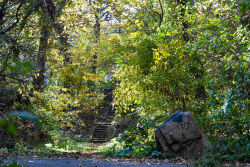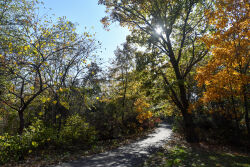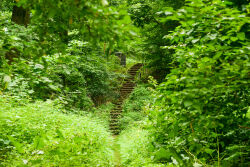Seton Falls Park
Seton Falls Park - the Forests of New York City
Although only 35 acres, Seton Falls Park has a surprisingly vital forest. Floodplain forest is present along Rattlesnake Creek, as are cattail marsh and sedge meadow, at the bottom of a sheer, rocky ravine. Floodplain forest grows on mineral soils in the lowlands of river floodplains and deltas. These areas are characterized by their flood regime: low areas are annually flooded in spring and high areas are flooded irregularly.
Above the ravine, oak-hickory and successional forests are dominant. Oak-hickory forests occur on well-drained sites, often on ridge tops, upper slopes, or south and west facing slopes. The soils are usually loams (mixtures of clay, sand, silt and organic matter). Successional forests grow on sites that have been cleared or otherwise disturbed, with the result being that the canopy layer of trees – the highest level providing leafy coverage – has not endured. These forests are dominated by particular species based on when they arrive.
There were no forests in New York City 15,000 years ago, as a glacier dominated the landscape. As the global climate warmed, the glacier receded and torrents of meltwater carried boulders, gravel, and sand that were deposited in a high ridge marking the southern limit of the glacier’s advance, called a terminal moraine. The dunes and drifts left behind by storms coming off the glacier were early sites of soil formation, providing an opportunity for plant growth.
As grasses, sedges, mosses, lichens, and shrubs began to colonize the area, their roots held the sand in place. Successive generations of dead plant material added organic matter and nutrients to the developing soil. The accumulating soil, with continued warming trends, allowed for the growth of more trees. These trees were widely spaced, and grasses and sedges remained a major component of the vegetation. Kettle ponds formed when huge chunks of ice that had been submerged under soil, finally melted and left deep depressions filled with water. Over time, forests took hold of the land.
There are four main layers to a forest: the canopy layer, the understory, the shrub layer, and the ground layer. The canopy layer is made of the tallest trees whose dense, leafy crowns absorb almost all of the sun’s light; sometimes only one percent filters through to the ground. Consequently, other forest plants have to adapt their structure, leaf emergence, and growth behaviors to get the nourishment they need from such a scarce resource. The understory is composed of small trees, which flower and leaf out at the same time as shrubs and can tolerate the lower light levels. Many birds reside here and the flora provides a space between the forest floor and the canopy for such animals as squirrels (Sciuridae), raccoons (Procyon lotor), and opossums (Didelphis marsupialis). The shrub layer consists of woodland shrubs that flower first, then leaf-out. Shrubs can range in height anywhere from knee-high plants to bushes that reach up ten feet or more into the understory. The ground layer is composed of the lowest growing forest plants, the wildflowers and ferns. These plants, which can be as low as a carpeting layer or weeds up to six feet tall, are the first plants to emerge in the spring.
Check out your park's Vital Signs
Clean & Safe
Green & Resilient
Empowered & Engaged Users
Share your feedback or learn more about how this park is part of a
Vital Park System

